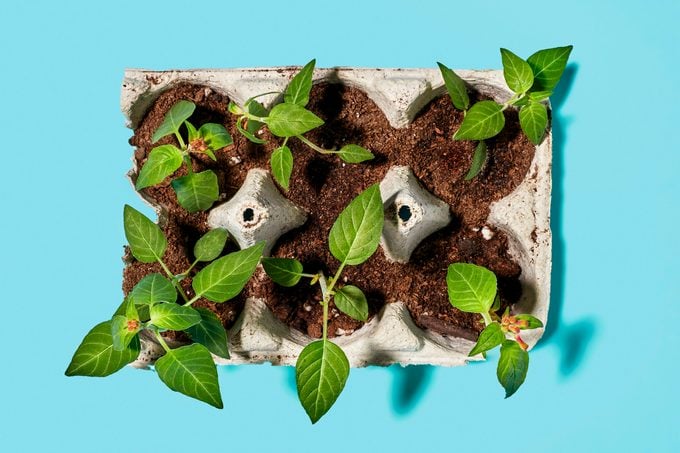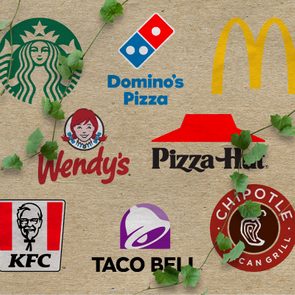What Is Sustainable Food, and How It Can Help Combat Climate Change
Updated: Oct. 04, 2022

Choosing sustainable food is vital to the health of the planet, but all the terminology can be confusing. We spoke to experts to get the facts.
If you’re interested in making changes toward a more sustainable lifestyle, your food choices are an easy place to start—they can have a positive impact on your health, the planet and future generations. And, you don’t have to grow all your own food; you just need to know more about sustainable foods and what to look for. But what is sustainable food, exactly? It goes beyond organic foods and sustainable fish and seafood to include farming practices, food systems, cultural knowledge and more. Read on to get the facts.
What does sustainable food really mean?
While there’s no official definition for “sustainable food,” it’s often taken to mean “food that can be harvested from the environment in a way that doesn’t degrade the environment’s ability to create that food in the future,” says Mike McDermid, director of fisheries and seafood at Ocean Wise, a nonprofit focused on protecting oceans.
In addition to consciously working to protect and improve the land, a sustainable food system includes fair treatment of employees, ethical treatment of livestock and sharing knowledge that can empower others, says Tamsin Wendt, chef and co-owner of Oceanview Eco Villas on Kangaroo Island in South Australia.
History of sustainable food
Although the term “sustainable food” only recently became popular with the general public, the concept is not new; sustainable practices are important to many Indigenous cultures and have been for thousands of years.
“Sustainability is integral to our survival,” says Melissa West, operations manager of Wukalina Walk, an Aboriginal-led immersive experience in Tasmania. “Our most important responsibility is to care for Country,” she says, explaining that “country” is a term used by Aboriginal people that encompasses land, waterways, ancestors, seasons, stories and more. “Harvesting and eating sustainably are our core values as pakana [Aboriginal people of Tasmania], and without this, Country suffers.”
Why is food sustainability important?
- It’s better for future food production. Regenerative farming, one of the cornerstones of sustainable food, includes sustainable methods such as managed grazing, tree intercropping, silvopasture, farmland restoration and conservation agriculture. According to a 2019 study, out of 80 ways to alleviate climate change, regenerative agriculture ranked No. 1 for sequestering greenhouse gasses.
- It’s healthier for the planet and for people. Food that is free of pesticides, chemicals and plastics creates less waste and is less damaging to the soil and ecosystems. Locally sourced food produces fewer carbon emissions as it doesn’t need to travel as far to get to your plate. There is also growing evidence that sustainable foods produced by regenerative farming practices are more nutrient-dense than foods produced by conventional farming methods.
- It contributes to the survival of cultural practices. Food is at the heart of culture, and the ability to continue to grow, harvest and prepare cultural foods allows for the perpetuation of cultural traditions and knowledge. “Protecting and sustaining resources not only ensures the health of Country, it also ensures our younger generations can experience integral parts of our culture and learn the knowledge our elders have carried for generations,” West says.

How to choose sustainable food
- Check the label for certifications. Fair Trade Certified, Food Alliance Certified or Rain Forest Certified Alliance are reliable indicators that the food was grown sustainably (see more on what each means below).
- Support local. “If you aren’t buying locally grown, your food may be traveling thousands of miles and then stored in large warehouses that are burning electricity,” which expends more natural resources and increases the carbon footprint, negatively impacting climate change, explains Bryan McMahon, executive chef at Hotel Wailea in Maui, Hawaii. Additionally, “smaller farms tend to use better soil and compost,” he says.
- Buy what’s in season. Food that’s out of season—think strawberries in December—has to travel farther to get to your grocery store. If there are fruits and veggies that you want to enjoy throughout the year, buy them in season and save them for later use by freezing, canning, pickling or preserving.
- Reduce your meat consumption. Not only does the meat industry create a large number of carbon emissions, but livestock also requires large plots of land, which may precipitate the clearing of forests and the disruption of natural ecosystems. Reducing your meat consumption helps reduce demand, which in turn can help cut back on waste, emissions and destruction of the environment.
- Consider the packaging. It’s not just what you eat, but how it’s packaged, that matters. Don’t buy produce in plastic clamshells, and bring your own reusable bag to the store or local farmers market so you can pass on plastic bags, McMahon says.
- Grow your own. If you have the ability and space to do so, consider growing some of your own food. Pick foods that are native to your area; crops that are accustomed to the climate and soil you put them in typically thrive more naturally.
- Reduce food waste. The less food you waste, the less food has to be produced. Aim to use as much of the fruit or vegetable as possible, find creative ways to use leftovers and try these other suggestions for reducing food waste.
- Ask questions. When booking restaurants or hotels, ask where they source ingredients and whether they have on-site gardens. “Make the effort to get to know their stories, and ask about sustainable food practices.” Wendt says.
Common sustainable food-related terms
Here are a few of the terms you may encounter while seeking out sustainable food. Keep in mind that this is only a selection, not a comprehensive list, and requirements for use of these labels vary by country.
General
- Organic. To earn the certified organic label in the U.S., food must be grown or raised without man-made chemicals or genetic engineering. In addition, farmers must make the best use of resources without depleting or making a negative impact on the environment.
- GMO. This stands for “genetically modified organisms,” meaning that the produce is genetically altered, typically in a lab, and does not naturally occur in the environment. Look for produce labeled “non-GMO” to ensure your food has not been altered genetically.
- Fair Trade Certified. To earn this certification from Trans Fair USA, producers must have safe and healthy working conditions, not use child labor, pay fair wages and have certain environmental protections in place.
- Food Alliance Certified. When you see this label from Food Alliance, you can rest assured that the product follows sustainable agriculture practices, its employees have safe and fair working conditions, and any animals are treated humanely.
- Rain Forest Alliance Certified. This rain forest–specific certification from the Sustainable Agriculture Network means that farmers follow sustainable agriculture guidelines and workers are treated fairly.
Meat and eggs
- Cage-free. This USDA term applies to eggs from chickens that are not caged and have unlimited access to food and water. It does not mean that the chickens have access to the outdoors. While all organic eggs are cage-free, not all cage-free eggs are organic.
- Free-range. Eggs labeled “free-range” meet the standards of “cage-free” plus the chickens must have unlimited access to the outdoors. Note, however, that the use of the term “free-range” does not indicate the size of the outdoor area or whether the animals actually went outdoors, only that they had access to it.
- Grass-fed. This label means that the animal was fed a grass diet, not a typical grain diet. In general, grass is healthier for these animals, and meat and eggs from grass-fed animals may be higher in nutrients. However, this label can be unreliable, and there is no regulation of this term for dairy. Instead, look for certifications with more specific requirements, such as PCO Certified 100% Grass Fed, American Grass Fed and Certified Grass Fed by AGW, that also consider animal welfare and additional eco-minded practices.
Fish
- Line-caught. Caught with a line rather than a net. Nets can cause injuries to other marine life, including sea turtles.
- Wild-caught. Wild-caught fish is sourced from its natural environment and has a natural diet that tends to include more variety than farm-raised.
- Farm-raised. Raised in man-made tanks or water pens. There is debate about which type of fish—wild or farmed—is better for the environment and has higher nutritional value. Experts suggest a balance of wild and farmed may be best when it comes to sustainability.
Conclusion
Choosing sustainable food can benefit the health of people and animals, local economies and the earth. The abundance of terms can be overwhelming, but you don’t have to know everything to do something. Think of it as an ongoing process—there is always more to learn, but that shouldn’t stop you from making some changes right away. Do your research, ask questions and team up with others to make a positive impact. The more you choose sustainably grown and sourced food and request it at grocery stores and restaurants, the more you’ll help to collectively move the needle.
Ready to do more? Learn about the importance of avoiding fast fashion and conserving water and how to travel in the most eco-friendly way.
Sources:
- Mike McDermid, director of fisheries and seafood at Ocean Wise
- Tamsin Wendt, chef at Oceanview Eco Villas on Kangaroo Island, South Australia
- Melissa West, operations manager of Wukalina Walk, an Aboriginal-led immersive experience in Tasmania
- Environmental Science: “Soil health and nutrient density: preliminary comparison of regenerative and conventional farming”
- Frontiers in Nutrition: “Is Grassfed Meat and Dairy Better for Human and Environmental Health?”
- Bryan McMahon, executive chef at Hotel Wailea in Maui, Hawaii






















